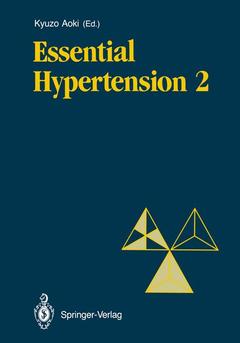Description
Essential Hypertension 2, Softcover reprint of the original 1st ed. 1989
Coordinator: Aoki Kyuzo
Language: English
Publication date: 04-2014
404 p. · 17x24.4 cm · Paperback
404 p. · 17x24.4 cm · Paperback
Description
/li>Contents
/li>
The First International Symposium on Mechanism and Treatment in Essential Hypertension was held on October 23 and 24, 1985 in Nagoya. The Second International Symposium, which was held on May 30,31, and June 1, 1988 in Nagoya, was a success thanks to the endeavors of all the participants. These symposiums were made possible by the generous support of the city of Nagoya, Aichi Prefec ture, and various contributions. Understanding of the mechanisms of gene (major gene, essential) hypertension is impossible unless we comprehend the physiological properties of arterial smooth muscle. Since Langendorff's discovery of the role of calcium ions in muscle contraction in 1895, we have made immense progress in our knowledge of the role of the calcium ion in the excitation-contraction coupling of the arterial smooth mus cle. Investigation of the molecular mechanisms controlling the cellu lar basis of calcium ion action has been established with the discovery of the calcium binding protein (Ebashi 1963). The participation of the calcium induced calcium mechanism in the contraction of muscle has been directly demonstrated by using chemically skinned smooth muscle fibers (Endo et al. 1977). Methods for intracellular free cal cium contents and calcium channel activity have been developed and contribute to the study of the role of the calcium ion in arterial smooth muscle contractility. Such recent progress promotes study of the basic physiological, biochemical, and molecular properties of the calcium channel, and, in the field of hypertension research, the sodium and potassium channels.
I Introduction: Spontaneously Hypertensive Rats and Classification of Hypertension.- Discovery and Development of the Spontaneously Hypertensive Rat.- Three-Way Classification of Hypertension: Gene Hypertension, Environment Hypertension, and Disease Hypertension.- II Calcium Movement During Contraction and Relaxation in Arterial Smooth Muscle.- Membrane Potential and Calcium Channels in Arterial Smooth Muscle Cells.- Excitatory Agonists and Ca-Permeable Channels in Arterial Smooth Muscle Cells.- Arterial Smooth Muscle Contraction Is Dependent on Sustained Increases in Myoplasmic Ca2+.- Role of Second Messengers on Mobilization of Calcium and Related Events in Vascular Smooth Muscles.- Myogenic Contraction and Relaxation of Arterial Smooth Muscle.- Relationship Between Cytosolic Calcium Level and Contractile Tension in Vascular Smooth Muscle.- Calcium Mobilization Mechanisms in Smooth Muscle.- Sarcoplasmic Reticulum of Mesenteric Arteries Buffers Stimulated Ca2+ Entry.- Contraction Induced by Ouabain and Potassium-free Solution in Human Umbilical Arteries.- Pharmacology of Calcium Antagonists in Arterial Smooth Muscle.- III Membrane Calcium-Handling Abnormalities of Vascular Smooth Muscle in Spontaneously Hypertensive Rats.- Increased Calcium Permeability of the Membrane of Vascular Smooth Muscle in Spontaneously Hypertensive Rats.- Membrane Potential and Calcium Influx in Vascular Muscle from Spontaneously Hypertensive Rats.- Cell Membrane Properties of the Arterial Smooth Muscle from Spontaneously Hypertensive Rats.- Decreased ?1-Adrenoceptor Reserve in Arteries from Spontaneously Hypertensive Rats.- Diminished ?-Adrenoceptor-Mediated Relaxation of Arteries from Spontaneously Hypertensive Rats.- Changes of Vascular ?- Adrenoceptors in Spontaneously Hypertensive Rats: Characterization and Technical Problems.- Vascular Mechanisms in Development and Maintenance of Hypertension in Spontaneously Hypertensive Rats.- Effects of Hypertension on Endothelial-Smooth Muscle Cell Interactions in Pressurized Cerebral Arteries.- Protective Effects of Calcium Antagonists on Hypertensive Diseases in Heart, Brain, and Kidney of Hypertensive Rats.- Hemodynamic and Hormonal Responses to Stimuli in Spontaneously Hypertensive Rats: Effects of Chronic Diltiazem Treatment.- Mechanism and Consequences of Cellular Calcium Elevation in Hypertension.- IV Calcium, Magnesium, and Calcium Antagonists in Human Hypertension.- Pressor Effects of Calcium Infusion in the Absence and Presence of a Calcium Antagonist in Subjects with Normotension and Hypertension.- Effects of Intravenous Infusion of Magnesium on Hemodynamics in Normotensives and Hypertensives.- Marked Blood Pressure Responses to Norepinephrine, Epinephrine, and Angiotensin II in Borderline Hypertension with a Parental History of Hypertension.- Responsiveness to Calcium Antagonists in Essential Hypertension: Pharmacokinetic and Neurohumoral Aspects.- Hemodynamic Effects of Calcium Antagonists at Rest and During Exercise in Essential Hypertension: A Comparison Between Verapamil, Diltiazem, Tiapamil, Nifedipine and Nisoldipine.- V Mechanism of Blood Plessure Elevation in Gene (Essential) Hypertension.- Calcium Metabolism in Hypertension: Clinical Evidence and Cellular Hypothesis.- The History of the Calcium Membrane Theory of Gene (Essential) Hypertension.- Index of Key Words.
© 2024 LAVOISIER S.A.S.
These books may interest you

Calcium Channel Pharmacology 158.24 €




